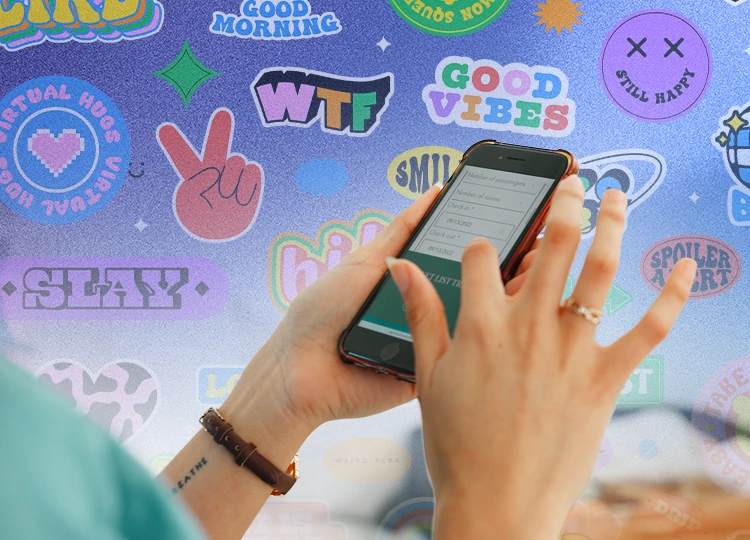How to Create Visual Experiences That Resonate With Today’s Most Digital-Savvy Generation
The older members of Gen Z have reached their mid-to-late 20s, and businesses are recognizing two essential facts: first, these consumers are starting to flex their economic muscle, as they now have established careers and disposable income and second, marketing to Gen Z is different than marketing to any other generation. That’s true because they are the first to grow up fully immersed in technology, and that upbringing has significantly shaped their shopping, buying, and information-consuming behaviors.
Consequently, brands must evolve to meet Gen Z’s unique preferences and expectations, and the designers who support brands must understand what that entails. In this article, we look at what it takes to develop designs that attract, engage, and influence Gen Z.

Gen Z’s Defining Characteristics
To design for Gen Z effectively, you’ve got to learn about them and their unique characteristics. They were born between 1996 and 2012, putting the younger members in their early teens and the older ones close to 30. Growing up in the mid-90s (and after) has created a unique set of traits for this demographic.
Digital Natives
The term “digital natives” gets tossed around a lot, but it truly applies to this generation. Unlike Millennials, who adapted to technology, Gen Z has never known a world without smartphones, social media, and anytime/anywhere connectivity. In fact, it’s fair to say that they’ve played a significant role in the evolution of technology, as they have been among the earliest adopters and unofficial “product testers” of many advances we now take for granted.
As a result, it’s not surprising that they have little patience for slow, clunky, or confusing interfaces or outdated and ineffective digital experiences. They know what’s possible, and if a company’s technology doesn’t deliver an outstanding user experience (UX), they’ll abandon it and use somebody else’s. That’s problematic for businesses, as nearly 95% of Gen Z members use social media, and they aren’t afraid to share their opinions on platforms frequented by millions of people. All it takes is one particularly creative or entertaining negative review going viral to doom a new offering or product upgrade.
Short Attention Spans
When it comes to content consumption, Gen Z isn’t known for its patience. That characteristic is understandable, given that they have been continually bombarded with information almost from birth. It’s been ingrained in them that there’s lots to see, do, and experience in the world, so if a piece of content isn’t engaging and scannable, they simply don’t have time for it.
Their perpetual information immersion (the average Gen Zer spends more than 10 hours online daily) has also made them very good at assessing the value of something at a glance. As a result, brands trying to appeal to Gen Z must get their message across quickly or risk being ignored. This doesn’t mean content can or should be shallow, but it must be delivered in easily digestible formats—short videos, infographics, compelling headlines, bullet points, etc. The goal is to hook them immediately, provide value upfront, and offer clear pathways for those who want to dive deeper. Designers need to prioritize visual hierarchy and content chunking to cater to this rapid consumption habit.

Visual Communicators
Members of Gen Z typically prefer images, video, and interactive media over text. They gravitate to visual-first content—think TikTok videos, GIFs, and emojis—rather than long blocks of text. Consequently, while explaining your offerings in words is still essential, text descriptions should not be the only thing (or even the first thing) you put in front of them.
Value Authenticity
Gen Z is skeptical of overly polished or inauthentic content. Their extensive exposure to marketing information has helped them (some might say forced them) to develop highly sensitive BS detectors. If anything about an ad, social post, or other marketing tool feels insincere, they will immediately reject the product or service and potentially the company behind it as well. They connect with brands that are transparent and real and form strong attachments. Nearly 75% of Gen Z members follow one or more brands on social media.
Authenticity for Gen Z often translates to genuine interactions, giving them looks behind the scenes, and working with relatable real-world influencers rather than paid spokespeople. This generation values brands that show their human side and aren’t afraid to address social issues or admit mistakes, fostering a sense of trust and community.
Socially Conscious
Gen Z cares deeply about issues like sustainability, diversity, and ethics, and they expect the brands they support to take stands that align with their values. That’s true even though, in some cases, they feel an issue is a lost cause. For example, 40% of Gen Z members believe it’s too late to fix climate change but still say that a brand’s environmental impact will influence their buying decisions.
Ultimately, they look for tangible actions and genuine commitment from brands, not just bold statements. Designers can reflect this by ensuring diverse representation in visuals and highlighting sustainable practices or social initiatives in clear and authentic ways.
Privacy-Aware
As life-long technology users, members of Gen Z understand that their personal information is a valuable resource. They’ve heard about major data breaches and understand how devastating they can be to the people affected. As a result, they are highly protective of their online privacy and insist on knowing how a company will use their data. As one measure of their preference for anonymity, 50% of Gen Z had used a virtual private network (VPN—essentially a private tunnel for accessing the internet that encrypts your data and hides your device’s location) in just the first two months of 2025.

Essential Design Principles for Connecting With Gen Z
When it comes to graphic design, Gen Z demands visually engaging, intuitive, and meaningful experiences. Here are some key design elements that capture their attention:
Bold, vibrant colors. Companies find they get better results when they leverage eye-catching color palettes that evoke emotion. Gen Z gravitates toward bright, energetic hues specifically. But that doesn’t mean you can just crank up the color saturation. The hues must evoke emotion and contribute to or reflect a brand’s personality. Generic or overly corporate colors won’t elicit a positive response from Gen Z.
Mix and match typography. Gen Z tends to interpret contrasting fonts and the dynamic visuals they create as representing self-expression and individuality. So, a design relying on a primary font and its variations (bold, light, italic, etc.) won’t earn high marks.
Authentic photography and illustration. Gen Z appreciates imagery that’s real, diverse, and relatable. Stock photos often feel staged and inauthentic. You should go beyond those types of images to find photos that look authentic, as they’re the ones that will help you connect with Gen Z and earn their trust. By some estimates, original photos get 35% more engagement than stock photos. Not all that engagement will translate into new business, but if even a fraction of it does, switching to original photos can be a very cost-effective marketing strategy.
Minimalist yet engaging. Gen Z favors clean layouts with high-impact visuals. Clutter-free designs are essential, but you shouldn’t equate minimal with boring. Strategic pops of color, texture, or interactivity help keep things fresh and viewers engaged.
Dark-mode friendly. It’s crucial that designs work in both light and dark modes, as many Gen Z users (73% in one Adobe survey) prefer dark mode for accessibility and aesthetics. Designs should be optimized for both light and dark themes.
Nostalgia meets modern. Gen Z likes retro-inspired elements with a fresh twist. Despite their digital focus, Gen Z loves nostalgic elements, especially when they’re blended with modern design trends—think retro fonts, grainy textures, or Y2K aesthetics.
Zero patience for bad UX. Seamless, intuitive, and fast digital experiences are essential if you want to get and hold the attention of Gen Z members. If a website or app is slow, hard to navigate, or outdated, they will leave and find a better alternative and probably never return. Speed, efficiency, and seamless positive experiences are non-negotiable.

Designs That Give Gen Z What They Want
Gen Z will continue to play an increasingly important role for most businesses as its younger members join the workforce and have money to spend. If you market your offerings using designs that align with their preferences, you stand to benefit.
Targeting Gen Z starts with creating seamless, mobile-first experiences. Your website, apps, and other interfaces should feature designs prioritizing mobile usability and ensuring every interaction is smooth and intuitive.
Your designs should be authentic and visually engaging. Gen Z values “realness,” so avoiding overly polished, corporate aesthetics and embracing more organic, relatable visuals is crucial. You should also provide opportunities for self-expression and personalization. Give users the ability to customize their experiences, whether through design elements, avatars, or themes.
Transparency and trust-building are essential for Gen Z audiences. Consequently, it’s crucial to be upfront about how you use their data and to align with causes that matter to them.
Keep in mind that Gen Z’s preferences shift rapidly. So, the most effective way to stay relevant to them is to iterate and evolve your designs. What works today may not work as well (or at all) tomorrow. Be adaptable and continuously refine your approach based on feedback and trends.
One of the best ways to stay on top of what’s getting Gen Z’s attention and earning their business is to work with an agency like ours. Our continual immersion in the art and science of appealing to different groups enables us to understand Gen Z’s behaviors and expectations and create campaigns that not only grab their attention but also keep them engaged in meaningful ways.
Contact us today!


